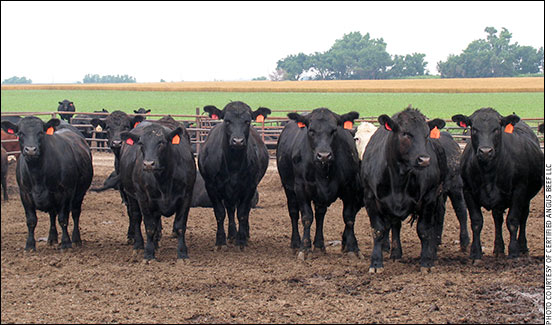
Manage to Maximize Grading and Pricing
Management strategies that avoid discounts provide significant opportunities.
The right genetics combined with sound management can improve profitability when it comes time to market feedlot cattle, says Ohio State University ruminant nutritionist Francis Fluharty.
“Quality grades predict palatability, and palatability is determined by fat. It is the overall combination of traits that lead to eating satisfaction, taste and flavor, tenderness, juiciness and mouth feel,” says Fluharty. “Prime grade is not based on days on feed. Quality grade is determined by marbling, and genetics affect the ability to marble. Research suggests the right marbling comes when animals are 167 to 236 days old and weigh 835 to 945 pounds (lb.).”
Fluharty says many animals that don’t grade USDA Choice at an advanced age probably would have graded Choice at a younger age with management and diet strategies that used a high-concentrate diet earlier in life. High levels of dietary vitamin A can reduce marbling by 30%.
In addition, beef gets darker as animals get older, which affects grade.
“Poor disposition and use of implants have a negative impact on quality grade, too,” he says. “Prior health history can influence carcass quality. Sick cattle mean lower quality grades.”
Yield grades predict the cutability, or the amount of boneless, closely trimmed retail cuts that can be obtained from the carcass. Yield grade is determined by criteria that include subcutaneous fat thickness at the 12th rib; ribeye area; hot carcass weight; and kidney, pelvic and heart fat.
“Both quality and yield grade go into grid pricing, and more than 70% of carcasses are marketed on that basis. Grid pricing varies from plant to plant and day to day,” he says. “Plants look at a number of factors, like the Choice-Select spread and drop credit. Choice [Yield Grade (YG)] 3 is used as the base in grid pricing to determine premiums and discounts with various yield and quality grades.”
Fluharty says the value difference between a USDA Prime YG 1 and a USDA Select YG 5 can be as much as $400, depending on the price and weight of the carcasses. He says YG 2s or lower YG 3s are the goal, and the main objective is to avoid YG 4 and 5 carcasses.
“Don’t chase premiums, but avoid discounts,” he says. “If 50%-60% of your cattle grade Choice and are efficient, you are OK in some regions of the U.S. Other regions require 80% or more Choice cattle. Control the diet, days on feed and amount of fat on them. You also need to know the market, and use risk-management tools.”
A heavier carcass does not always mean more profit, especially if the cattle don’t have the genetics to perform, he adds. For example, if a steer appears to gain $60 in carcass value with more days on feed, count in yardage and feed costs. With $136 more additional cost of gain, you end up with a $76 loss of revenue. That is the loss from a YG 3 to a YG 4 and 1,210 lb. to 1,300 lb.
In the future, Fluharty predicts discounts will be greater for cattle that are too small [ribeyes less than 10 square inches (sq. in.)] or too large (ribeyes larger than 13 or 14 sq. in.) for the case and excessively fat. Use of growth promoters and feed additives may also negatively impact pricing.
“Know what affects the eating quality of your beef product before you use it,” Fluharty says.

Editor’s Note: A former National Junior Angus Board member, Barb Baylor Anderson is a freelancer from Edwardsville, Ill.





